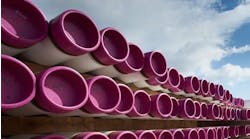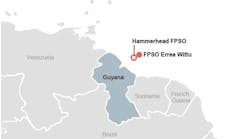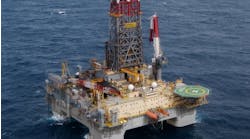Offshore Brazil oil and gas developments and projects continue to ramp up
By Ariana Hurtado, Editor and Director of Special Reports
Brazil is undoubtedly a hot region, with offshore project updates being released on almost a weekly basis throughout 2024.
“In terms of liquids production, Brazil is expected to see the highest growth in offshore production amongst all countries globally by 2030 as compared to 2024 levels,” Santosh Kumar Budankayala, vice president of upstream research with Rystad Energy, told Offshore.
“In 2025, Petrobras is expected to lead in terms of offshore exploratory drilling yet again. It has been trying to acquire drilling permits to drill in the Foz do Amazonas Basin. If these permits come through, this would be a significant breakthrough as it has been struggling to get approval to drill in this basin. It has also reaffirmed in exploration investment plans in its 2024-2028 exploration strategy where it unveiled plans to invest US$7.5 billion in exploration investments to drill ~40 wells across Brazil’s southeastern and Equatorial margin basins.”
International operators slowed down drilling activity in 2024 due to mixed results seen in earlier years, Budankayala added. However, bp is expected to drill in late 2025 or in 2026 in the Bumerangue and Tupinamba blocks. bp also drilled its first well offshore Brazil as an operator in almost 11 years after it spud a well in the Pau Brasil Block in 2024.
Industry news
Two more SBM newbuild FPSOs nearing completion
SBM Offshore provided a status report Nov. 14 on its newbuild FPSOs, either completed or under construction at shipyards in the Far East.
The Almirante Tamandaré reached its offshore destination at the Búzios field in the Santos Basin offshore Brazil in October, and it is now undergoing installation, hookup and offshore commissioning. Petrobras anticipates first oil in early 2025.
Integration work has finished on the Alexandre de Gusmão, the fourth permanent production systems at the Mero field in the Santos Basin, with the present focus on commissioning activities until sailaway around year-end 2024. First oil should follow in 2025.
Omni Táxi Aéreo to provide helicopter services at Bacalhau
Omni Táxi Aéreo, an affiliate of Omni Helicopters International (OHI), has been selected by Equinor Brazil to provide helicopter services for its offshore activities at the Bacalhau Field in the Santos Basin, according to an Oct. 28 OHI news release.
The basin, currently under full development, will host one of the largest FPSOs in the world, with a production capacity of up to 220,000 bbl/d of oil.
Operations will be conducted from Omni Táxi Aéreo’s base at Jacarepaguá Airport in Rio de Janeiro. Omni will deploy three helicopters to fulfil this contract. Omni says it is the only company in Brazil operating the AW189 and H175 models.
History of success offshore Brazil
“Brazil has seen huge discoveries made in the past, with Tupi being the first large discovery that was made in 2006. Buzios was another large find that was made in 2010. Both of them being multibillion barrel finds,” Budankayala said. “Operators have tried to recreate this success over the past few years and have seen mixed results.”
From 2017 to 2019, companies spent more than US$11 billion in acquiring blocks across the Campos and Santos basins, which the Rystad analyst deems an indication there is “some untapped potential.”
“However, exploration activity since 2014 has not resulted in any multibillion-barrel finds as was seen in the past,” Budankayala added. “Over the past few years, international operators such ax Exxon, Shell, bp, Equinor and Petronas have spun their drillbits in search of discoveries, [and] Petrobras has also continued to perform exploratory drilling.
Outlook
Brazil’s oil and gas production is estimated to increase over the next five years, peaking in the early 2030s, driven by the country’s offshore presalt discoveries, according to a September 2024 Rystad Energy report.
According to Rystad, Petrobras remains “a dominant operator” in South America.
Petrobras investments in third-quarter 2024 totaled $4.5 billion, with the company continuing to focus primarily on large presalt projects. In the first nine months of 2024, total investments reached $10.9 billion, the company reported.
Rystad reports a positive near-term production outlook for Brazil, but it forecasts the country should expect a decline to begin in the next decade.
“This presents the challenge of reserve replacement to sustain production and stem the decline,” the report stated. “One solution is infrastructure-led exploration (ILX), utilizing increasingly spare infrastructure capacity in the mature Campos and Santos basins to commercialize smaller, undeveloped accumulations.”
The market intelligence firm says previously relinquished discoveries could be developed by leveraging existing infrastructure. The Campos and Santos basins contain more than 40 fields with more than 3 Bboe in relinquished discoveries.
“However, regulatory agencies play an important role in developing these discovered but relinquished resources,” the report stated. “For ILX developments to move forward in these blocks, Brazil's National Petroleum Agency (ANP) would need to offer them in future bid rounds or permanent offers. Additionally, regulations around infrastructure sharing need to be developed to ensure efficiency gains across all operators in the region.”
Industry news continued...
Three Solstad vessels have assignments extended offshore Brazil
Solstad Offshore has won multiple offshore vessel contracts from unnamed clients in Brazil with a combined value approaching $53 million, according to an Oct. 25 news release.
The Normand Topazio anchor-handling tug supply (AHTS) vessel has a one-year contract that was due to start in October, in direct continuation of the vessel’s current contract. Another AHTS, Normand Turmalina, has a similar arrangement that is due to take effect in November. Solstad Offshore owns both vessels.
The Normand Cutter construction support vessel, owned by Solstad Maritime (Solstad Offshore, 27%) has a nine-month contract for subsea construction work that was due to start in October.
Baker Hughes to provide corrosion-countering pipes for Petrobras presalt fields
Petrobras has contracted Baker Hughes to supply 77 km of flexible pipe systems for deployment in deepwater presalt fields offshore Brazil, according to an Oct. 28 press release.
The multi-year program covers risers and flowlines for hydrocarbon production and associated gas and water injection, with support for equipment storage, maintenance and installation.
Deliveries should start in mid-2026; the systems will be featured at the Búzios, Libra, Berbigão, Sururu and Sépia fields.
Baker Hughes said the design will also address stress-induced corrosion cracking from CO2, which can impact flexible pipes in presalt fields with high concentrations of the gas.
Santos Basin updates
On Oct. 30, the Marechal Duque de Caxias (Mero 3) FPSO began producing oil and gas at the Mero Field in the Libra Block in the presalt Santos Basin. The FPSO has the capacity to produce up to 180,000 bbl/d of oil and compress up to 12 MMcm/d of gas.
Also in October, the Almirante Tamandaré FPSO arrived in Brazil from China. This unit will be installed at the Búzios Field in the Santos Basin. The Almirante Tamandaré is the first high-capacity FPSO to be deployed in the field, Petrobras reported, and it has the potential to produce up to 225,000 bbl/d of oil and process 12 MMcm/d of gas.
Rystad reported that output has increased in the Santos Basin since the first presalt ultradeepwater discovery in 2006, which has led to the Tupi and Buzios field developments. The Santos Basin accounted for 74% of Brazil’s total output in 2023, and Rystad predicts it will contribute 80% by 2030. “However, after this production peak, Brazil’s output is projected to decline by an average of 10% annually through 2050,” the report stated.
Campos Basin updates
The Campos Basin “dominated Brazil’s offshore sector before the presalt developments,” Rystad reported. The basin has been producing for more than 45 years, mainly due to life extension projects. For example, nine platforms at the Marlim Field were replaced in 2023 by two new FPSOs as part of a revitalization program. Several previously producing wells will be reconnected to the Anita Garibaldi and Anna Nery FPSOs, which are designed to be able to sustain higher water cuts due to their higher water processing capacity.
The Maria Quitéria FPSO, which was originally scheduled to begin operations in 2025, produced its first oil early on Oct. 15. Installed at the Jubarte Field in the presalt Campos Basin, this FPSO can produce up to 100,000 bbl/d of oil and process up to 5 MMcm/d of gas.
FPSOs
“Brazil accounts for 45 of the 167 FPSOs operating worldwide, and 15 of the 36 FPSOs on order are destined for the country, representing over 40% of global demand,” the report stated. “Brazil's established FPSO market, combined with its expertise in deepwater developments, allows companies to consider redeploying FPSOs to commercialize undeveloped projects.”
Subsea spending
Brazil is driving strong demand for subsea equipment and SURF, according to another Rystad report released in mid-August. “Anticipated expenditure in Brazil is set to surge 18% from the previous year, to $6 billion in 2024,” the report stated.
Global ultradeepwater projects, driven by major FPSO initiatives in Brazil and Guyana, are projected to capture 35% of the market. South America is expected to lead globally with 500 subsea tree installations over the next five years. Upcoming ultradeepwater greenfield projects (beyond 1,500 m) include Yellowtail, Tilapia and Redtail in Guyana, alongside Buzios VIII, Buzios IX, Sepia and Atapu in Brazil.
In the SURF sector, global installations are expected to reach 3,500 km in 2024, and Brazil is forecast to account for 22% of that total. The installation rate is projected to increase at a CAGR of 15% from 2024 to 2028, with Brazil being one of the major markets.
In the coming years, TechnipFMC is expected to supply about 400 subsea trees between 2024 and 2029. Of this total, 22% is estimated for Petrobras in Brazil. At the same time, OneSubsea is projected to supply close to 270 subsea trees within the same period, with about 40% estimated for Brazil.
Industry news continued...
SBM downsizes stake in Mero FPSO offshore Brazil
SBM Offshore has divested a 13.5% interest in the companies that lease and operate the Sepetiba FPSO to China Merchants Financial Leasing (Hong Kong) Holding Co., according to an Oct. 24 news release.
The platform produces oil from the Mero Field in the Santos Basin, 180 km from Rio de Janeiro.
Petrobras operates Mero in partnership with Shell Brasil, TotalEnergies, CNPC, CNOOC and Pré-Sal Petróleo. SBM Offshore will continue to operate the FPSO with a 51% ownership interest.
Kongsberg Maritime wins power order for Brazil PSVs
Kongsberg Maritime will supply equipment for 10 new platform supply vessels (PSVs) under construction by Fujian Mawei Shipbuilding in China for Capital Offshore, according to an Oct. 22 news release.
Piraeus-based Capital Offshore, which owns and operates more than 100 vessels, has ordered the 95-m-long, MMC 897 CD-design PSVs for operations offshore Brazil. Each vessel will feature an integrated electrical system, propulsion and energy controls.
Brava Energia cleared to use Papa-Terra workover rig offshore Brazil
Brava Energia received authorization in October from Brazil’s national agency (ANP) concerning activities at the offshore Papa-Terra oil field in the Campos Basin.
The company can now increase the number of people on board the tension-leg wellhead platform 3R-2 and the FPSO 3R-3, as well as using the rig installed in 3R-2, prior to resuming production in December.
Brava plans to use the rig to continue a workover of well PPT-051 to replace the submersible pumping system.
Another letter from ANP calls for scheduling of the final inspection of the FPSO Atlanta's measurement systems between Nov. 25 and 29, after which Brava will conclude its submission to ANP of the other conditions responses for the FPSO Atlanta to start operations.
In September Brazil’s environmental agency issued the operating license for the platform. In parallel, Brava will start the decommissioning process for the FPSO Petrojarl in early November.
OneSubsea to provide subsea equipment for Roncador project
SLB OneSubsea was recently awarded a contract by Petrobras for the Roncador project offshore Brazil, according to an Oct. 11 news release.
SLB OneSubsea, a joint venture comprising SLB, Aker Solutions and Subsea7, will provide two subsea production manifolds, one electro-hydraulic distribution unit and additional related services.
The project supports the further development of the Roncador Field in the Campos Basin. Roncador is one of Brazil’s five largest producing assets and has been in production since 1999. OneSubsea says provision of an effective subsea solution will help improve recovery from the mature oil field.
SLB OneSubsea will provide the full subsea equipment scope to this project, including subsea production manifolds, subsea control systems, distribution units and toolkits, as well as field services for installation, commissioning, intervention, preservation and maintenance.
Petrobras, Shell sign up more Pelotas Basin offshore blocks
Petrobras has signed three more concession contracts for blocks in the Pelotas Basin offshore southern Brazil, according to an Oct. 14 press release.
The contracts for blocks P-M-1737, P-M-1739 and P-M-1797, acquired in partnership with Shell and CNOOC, were the last three that remained from Brazil’s 4th Permanent Concession Offer Cycle, offered by the ANP in December 2023. Petrobras operates all three with a 50% stake, while Shell and CNOOC hold 30% and 20%, respectively. In total, Petrobras acquired 29 concession contracts in the Pelotas Basin under the auction.

Ariana Hurtado | Editor-in-Chief
With more than a decade of copy editing, project management and journalism experience, Ariana Hurtado is a seasoned managing editor born and raised in the energy capital of the world—Houston, Texas. She currently serves as editor-in-chief of Offshore magazine, overseeing the editorial team, its content and the brand's growth from a digital perspective.
Utilizing her editorial expertise, she manages digital media for the Offshore team. She also helps create and oversee new special industry reports and revolutionizes existing supplements, while also contributing content to Offshore magazine, its newsletters and website as a copy editor and writer.
Prior to her current role, she served as Offshore's editor and director of special reports from April 2022 to December 2024.
Before joining Offshore, she served as senior managing editor of publications with Hart Energy. Prior to her nearly nine years with Hart, she worked on the copy desk as a news editor at the Houston Chronicle.
She graduated magna cum laude with a bachelor's degree in journalism from the University of Houston.





